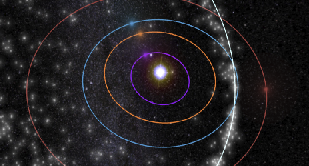The Perseid meteor shower started in mid-July, but will peak during the next few days, before coming to an end in late August.

The Perseid meteor shower is one of the best meteor showers of the year. It forms from debris that trails the comet, 109P/Swift-Tuttle. The comet was discovered by Lewis Swift and Horace Tuttle back in 1862. According to NASA, “Swift-Tuttle last reached perihelion (closest approach to the Sun) in 1992 and will return again in 2125.”
We actually see the meteor shower because the Earth is revolving around the sun and traveling through the leftover dust that is trailing Swift-Tuttle in its orbit.
You may ask, “How is leftover ‘dust’ causing a problem?” Well the dust is actually pretty big. The comet is estimated to be about 16 miles across (the one that killed the dinosaurs was less than 10 miles). So cosmic dust that breaks off and trails the comet can actually be pretty large
From https://apod.nasa.gov:
Explanation: Where do Perseid meteors come from? Mostly small bits of stony grit, Perseid meteoroids were once expelled from Comet Swift-Tuttle and continue to follow this comet’s orbit as they slowly disperse. The featured animation depicts the entire meteoroid stream as it orbits our Sun. When the Earth nears this stream, as it does every year, the Perseid Meteor Shower occurs. Highlighted as bright in the animation, comet debris this size is usually so dim it is practically undetectable. Only a small fraction of this debris will enter the Earth’s atmosphere, heat up and disintegrate brightly. This weekend promises some of the better skies to view the Perseid shower as well as other active showers because the new moon will not only be faint, it will be completely absent from the sky for most of the night. Although not outshining faint Perseids, the new moon will partially obstruct the Sun as a partial solar eclipse will be visible from some northern locations.
NASA has some good info about comets, too:
Comets are cosmic snowballs of frozen gases, rock and dust that orbit the Sun. When frozen, they are the size of a small town. When a comet’s orbit brings it close to the Sun, it heats up and spews dust and gases into a giant glowing head larger than most planets. The dust and gases form a tail that stretches away from the Sun for millions of miles. There are likely billions of comets orbiting our Sun in the Kuiper Belt and even more distant Oort Cloud. The current number of known comets is: 3,530
So what happens when all of the gas and ice sublimates (Sublime is a cool word! It means to change directly from a solid into vapor when heated) and all that is left is the rocks? You get a an asteroid. According to researchers at Indiana Universty, “After 500 or so passes near the Sun off most of a comet’s ice and gas is lost leaving a rocky object very much like an asteroid in appearance. (Perhaps half of the near-Earth asteroids may be “dead” comets.)”

